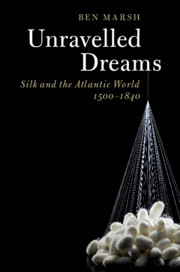Book contents
- Unravelled Dreams
- Unravelled Dreams
- Copyright page
- Dedication
- Contents
- Colour Plates
- Figures
- Maps
- Tables
- Acknowledgements
- 1 Prologue
- Part I Emergence
- 2 Spain and New Spain
- 3 England and Virginia
- 4 France and New France
- Part II Persistence
- Part III Convergence
- Select Bibliography
- Index
- Plate Section (PDF Only)
2 - Spain and New Spain
from Part I - Emergence
Published online by Cambridge University Press: 08 October 2020
- Unravelled Dreams
- Unravelled Dreams
- Copyright page
- Dedication
- Contents
- Colour Plates
- Figures
- Maps
- Tables
- Acknowledgements
- 1 Prologue
- Part I Emergence
- 2 Spain and New Spain
- 3 England and Virginia
- 4 France and New France
- Part II Persistence
- Part III Convergence
- Select Bibliography
- Index
- Plate Section (PDF Only)
Summary
The sixteenth century would witness the remarkable rise of silk production in the Spanish Empire, as Iberian conquistadors and caterpillars converged upon Meso-American Indians and mountain forests. By the 1560s, amidst the brutal extraction of gold and silver, silk production had blossomed into one of the Americas’ first post-Columbian cash crops, and for a time it sustained a manufacturing industry that helped satiate the growing markets of a Latinising America. Perhaps strangely, this first colonial attempt at establishing silk cultivation across the Atlantic – rooting in Oaxaca – would prove unquestionably the most successful of all those in the Americas, linking the victims of the European Reconquista with those of the American Conquista: a Moorish speciality became a Mixtecan Indian opportunity. But it was a function of the dramatic pace of global interconnection in the sixteenth century that, within four decades of the first harvesting of American raw silk in the 1540s, the first Asian raw silk in bulk arrived from the other direction, across the Pacific. A commercial battle followed between the valuable fibrous proteins emitted by the silkworms of Granada (in Spain and New Spain), and those of their long-distant ancestors in China. Its result, the collapse of raw silk production in New Spain, was heavily influenced by the decline of Indian populations and the paranoia of the Spanish Crown in terms of protecting peninsular interests.
Keywords
- Type
- Chapter
- Information
- Unravelled DreamsSilk and the Atlantic World, 1500–1840, pp. 43 - 97Publisher: Cambridge University PressPrint publication year: 2020

